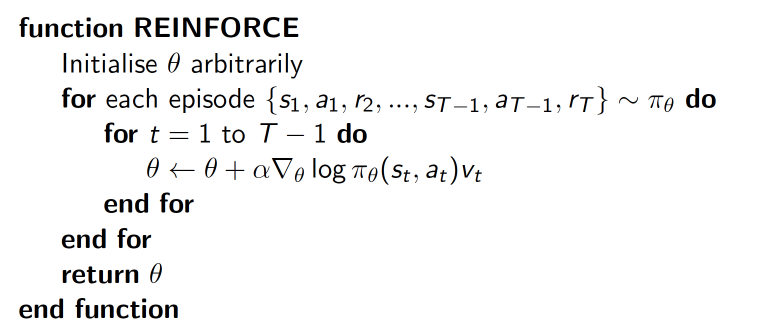深度增强学习--Policy Gradient
前面都是value based的方法,现在看一种直接预测动作的方法 Policy Based
Policy Gradient

下面的例子实现的REINFORCE算法
import sys
import gym
import pylab
import numpy as np
from keras.layers import Dense
from keras.models import Sequential
from keras.optimizers import Adam EPISODES = 1000 #policy gradient的一种,REINFORCE算法
# This is Policy Gradient agent for the Cartpole
# In this example, we use REINFORCE algorithm which uses monte-carlo update rule
class REINFORCEAgent:
def __init__(self, state_size, action_size):
# if you want to see Cartpole learning, then change to True
self.render = True
self.load_model = False
# get size of state and action
self.state_size = state_size#
self.action_size = action_size# # These are hyper parameters for the Policy Gradient
self.discount_factor = 0.99
self.learning_rate = 0.001
self.hidden1, self.hidden2 = 24, 24 # create model for policy network
self.model = self.build_model() # lists for the states, actions and rewards
self.states, self.actions, self.rewards = [], [], [] if self.load_model:
self.model.load_weights("./save_model/cartpole_reinforce.h5") # approximate policy using Neural Network
# state is input and probability of each action is output of network
def build_model(self):
model = Sequential()
model.add(Dense(self.hidden1, input_dim=self.state_size, activation='relu', kernel_initializer='glorot_uniform'))
model.add(Dense(self.hidden2, activation='relu', kernel_initializer='glorot_uniform'))
model.add(Dense(self.action_size, activation='softmax', kernel_initializer='glorot_uniform'))
model.summary()
# Using categorical crossentropy as a loss is a trick to easily
# implement the policy gradient. Categorical cross entropy is defined
# H(p, q) = sum(p_i * log(q_i)). For the action taken, a, you set
# p_a = advantage. q_a is the output of the policy network, which is
# the probability of taking the action a, i.e. policy(s, a).
# All other p_i are zero, thus we have H(p, q) = A * log(policy(s, a))
model.compile(loss="categorical_crossentropy", optimizer=Adam(lr=self.learning_rate))
return model # using the output of policy network, pick action stochastically
def get_action(self, state):
policy = self.model.predict(state, batch_size=1).flatten()#
return np.random.choice(self.action_size, 1, p=policy)[0]#choose action accordding to probability # In Policy Gradient, Q function is not available.
# Instead agent uses sample returns for evaluating policy
def discount_rewards(self, rewards):
discounted_rewards = np.zeros_like(rewards)
running_add = 0
for t in reversed(range(0, len(rewards))):
running_add = running_add * self.discount_factor + rewards[t]
discounted_rewards[t] = running_add
return discounted_rewards # save <s, a ,r> of each step
def append_sample(self, state, action, reward):
self.states.append(state)
self.rewards.append(reward)
self.actions.append(action) # update policy network every episode
def train_model(self):
'''
example:
self.states:[array([[-0.00647736, -0.04499117, 0.02213829, -0.00486359]]), array([[-0.00737719, -0.24042351, 0.02204101, 0.2947212 ]]), array([[-0.01218566, -0.04562261, 0.02793544, 0.00907036]]), array([[-0.01309811, -0.24113382, 0.02811684, 0.31043471]]), array([[-0.01792078, -0.04642351, 0.03432554, 0.02674995]]), array([[-0.01884925, -0.24202048, 0.03486054, 0.33006229]]), array([[-0.02368966, -0.04741166, 0.04146178, 0.04857336]]), array([[-0.0246379 , -0.24310286, 0.04243325, 0.35404415]]), array([[-0.02949995, -0.43880168, 0.04951413, 0.65979978]]), array([[-0.03827599, -0.2444025 , 0.06271013, 0.38310959]]), array([[-0.04316404, -0.44035616, 0.07037232, 0.69488702]]), array([[-0.05197116, -0.63637999, 0.08427006, 1.00886738]]), array([[-0.06469876, -0.83251953, 0.10444741, 1.32677873]]), array([[-0.08134915, -0.63885961, 0.13098298, 1.06852366]]), array([[-0.09412634, -0.44569036, 0.15235346, 0.8196508 ]]), array([[-0.10304015, -0.25294509, 0.16874647, 0.57850069]]), array([[-0.10809905, -0.44997994, 0.18031649, 0.91923131]]), array([[-0.11709865, -0.25769299, 0.19870111, 0.68820344]])]
self.rewards:[1.0, 1.0, 1.0, 1.0, 1.0, 1.0, 1.0, 1.0, 1.0, 1.0, 1.0, 1.0, 1.0, 1.0, 1.0, 1.0, 1.0, -100]
self.actions:[0, 1, 0, 1, 0, 1, 0, 0, 1, 0, 0, 0, 1, 1, 1, 0, 1, 1]
'''
episode_length = len(self.states)# discounted_rewards = self.discount_rewards(self.rewards)
'''
example:
disconnted_rewards:array([ -68.58863868, -70.29155422, -72.01167093, -73.74916255,-75.5042046 , -77.27697434, -79.06765085, -80.876415 , -82.7034495 , -84.54893889, -86.41306958, -88.29602988,-90.19800998, -92.119202 , -94.0598,-96.02,-98., -100. ])
'''
discounted_rewards -= np.mean(discounted_rewards)
discounted_rewards /= np.std(discounted_rewards)#将作为神经网络预测对象
'''
array([ 1.59468271, 1.41701722, 1.23755712, 1.05628429, 0.87318042,
0.68822702, 0.50140541, 0.3126967 , 0.12208185, -0.0704584 ,
-0.26494351, -0.46139311, -0.65982705, -0.86026537, -1.06272832,
-1.26723636, -1.47381013, -1.6824705 ])
'''
update_inputs = np.zeros((episode_length, self.state_size))#shape(18,4)
advantages = np.zeros((episode_length, self.action_size))#shape(18,2) for i in range(episode_length):
update_inputs[i] = self.states[i]
advantages[i][self.actions[i]] = discounted_rewards[i] self.model.fit(update_inputs, advantages, epochs=1, verbose=0)
self.states, self.actions, self.rewards = [], [], [] if __name__ == "__main__":
# In case of CartPole-v1, you can play until 500 time step
env = gym.make('CartPole-v1')
# get size of state and action from environment
state_size = env.observation_space.shape[0]
action_size = env.action_space.n # make REINFORCE agent
agent = REINFORCEAgent(state_size, action_size) scores, episodes = [], [] for e in range(EPISODES):
import pdb; pdb.set_trace()
done = False
score = 0
state = env.reset()
state = np.reshape(state, [1, state_size]) while not done:
if agent.render:
env.render() # get action for the current state and go one step in environment
action = agent.get_action(state)
next_state, reward, done, info = env.step(action)
next_state = np.reshape(next_state, [1, state_size])
reward = reward if not done or score == 499 else -100 # save the sample <s, a, r> to the memory
agent.append_sample(state, action, reward) score += reward
state = next_state if done:
# every episode, agent learns from sample returns
agent.train_model() # every episode, plot the play time
score = score if score == 500 else score + 100
scores.append(score)
episodes.append(e)
pylab.plot(episodes, scores, 'b')
pylab.savefig("./save_graph/cartpole_reinforce.png")
print("episode:", e, " score:", score) # if the mean of scores of last 10 episode is bigger than 490
# stop training
if np.mean(scores[-min(10, len(scores)):]) > 490:
sys.exit() # save the model
if e % 50 == 0:
agent.model.save_weights("./save_model/cartpole_reinforce.h5")
深度增强学习--Policy Gradient的更多相关文章
- 强化学习--Policy Gradient
Policy Gradient综述: Policy Gradient,通过学习当前环境,直接给出要输出的动作的概率值. Policy Gradient 不是单步更新,只能等玩完一个epoch,再 ...
- 深度增强学习--DDPG
DDPG DDPG介绍2 ddpg输出的不是行为的概率, 而是具体的行为, 用于连续动作 (continuous action) 的预测 公式推导 推导 代码实现的gym的pendulum游戏,这个游 ...
- 深度增强学习--A3C
A3C 它会创建多个并行的环境, 让多个拥有副结构的 agent 同时在这些并行环境上更新主结构中的参数. 并行中的 agent 们互不干扰, 而主结构的参数更新受到副结构提交更新的不连续性干扰, 所 ...
- 深度增强学习--Actor Critic
Actor Critic value-based和policy-based的结合 实例代码 import sys import gym import pylab import numpy as np ...
- 深度增强学习--Deep Q Network
从这里开始换个游戏演示,cartpole游戏 Deep Q Network 实例代码 import sys import gym import pylab import random import n ...
- 深度增强学习--DPPO
PPO DPPO介绍 PPO实现 代码DPPO
- 深度增强学习--DQN的变形
DQN的变形 double DQN prioritised replay dueling DQN
- Deep Learning专栏--强化学习之从 Policy Gradient 到 A3C(3)
在之前的强化学习文章里,我们讲到了经典的MDP模型来描述强化学习,其解法包括value iteration和policy iteration,这类经典解法基于已知的转移概率矩阵P,而在实际应用中,我们 ...
- 增强学习 | AlphaGo背后的秘密
"敢于尝试,才有突破" 2017年5月27日,当今世界排名第一的中国棋手柯洁与AlphaGo 2.0的三局对战落败.该事件标志着最新的人工智能技术在围棋竞技领域超越了人类智能,借此 ...
随机推荐
- 内置函数补充,__str__方法、__del__方法 和 __call__方法和元祖
一 .内置函数补充 1.isinstance函数: isinstance(obj,cls)检查obj是否是类 cls 的对象 使用该函数来判断一个函数的类型 2. issubclass(sub, su ...
- CentOS 7 部署nginx
**二进制安装 安装Nginx源 rpm -ivh http://nginx.org/packages/centos/7/noarch/RPMS/nginx-release-centos-7-0.el ...
- ZOJ 3599 K倍动态减法游戏
下面的文字辅助理解来自http://blog.csdn.net/tbl_123/article/details/24884861 博弈论中的 K倍动态减法游戏,难度较大,参看了好多资料才懵懂! 此题可 ...
- 【反演复习计划】【bzoj3529】数表
Orz PoPoQQQ大爷 按照他ppt的解法,这题可以划归到之前的题了OrzOrz 跪wy写的题解(Stealth Assassin)https://www.luogu.org/wiki/show? ...
- 【洛谷P3709】大爷的字符串题
看这题网上居然还没人写blog,怕是都去看洛谷自带的了-- 你才是字符串!你全家都是字符串!这题跟字符串没多大关系,只是出题人lxl想要吐槽某中学而已--... 其实这题说白了就是问区间里出现最多的数 ...
- 用js和jQuery做轮播图
Javascript或jQuery做轮播图 css样式 <style> a{ text-decoration:none; } .naver{ width: 100%; position:r ...
- Redis-4.0.8 readme.md
This README is just a fast *quick start* document. You can find more detailed documentation at [redi ...
- 《锋利的JQuery》读书要点笔记5——jQuery与Ajax的应用
第6章 jQuery与Ajax的应用 Ajax的全称:Asynchronous JavaScript and XML (异步Javascript和XML) 传统模式中,数据提交通过表单方式实现,数据的 ...
- 使用Postman访问OAuth2保护的WebAPI
Instantnoodle现时的WebAPI已经受Azure AD保护,平时直接输入URL的方式已经不能够正常访问到WebAPI 所有API都可以Swagger页面找到 http://getazdev ...
- 2017 ACM-ICPC 亚洲区(青岛赛区)网络赛 1010
#include<iostream> #include<cstdio> #include<cmath> #include<cstring> #inclu ...
